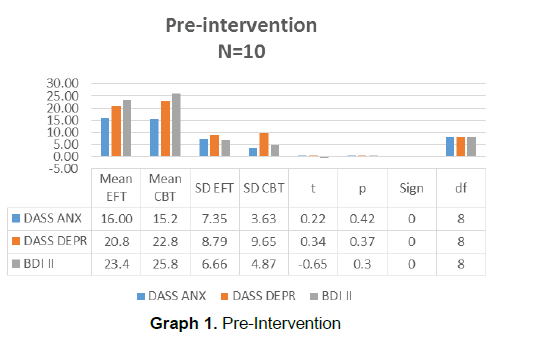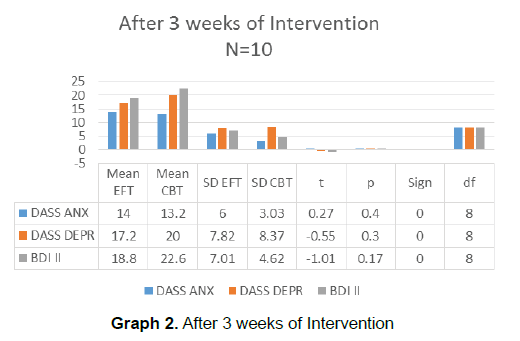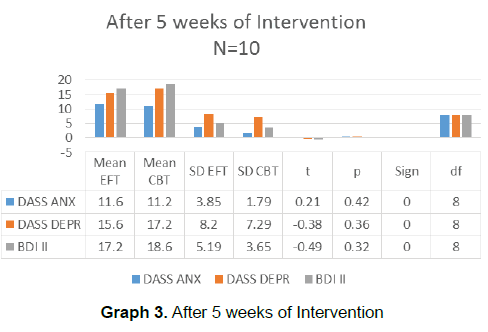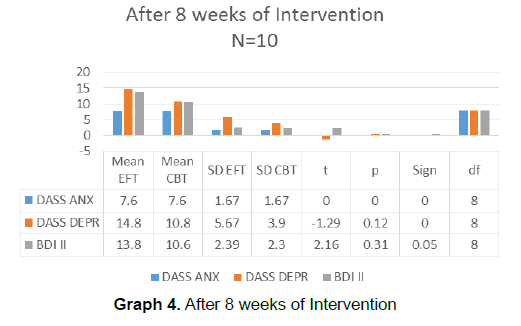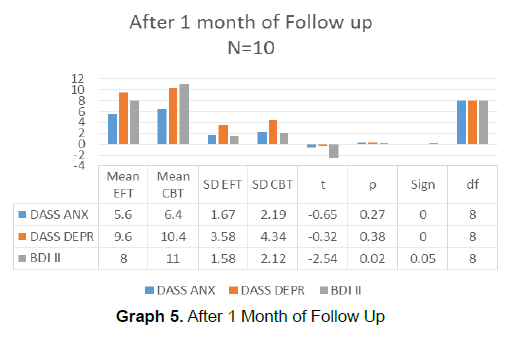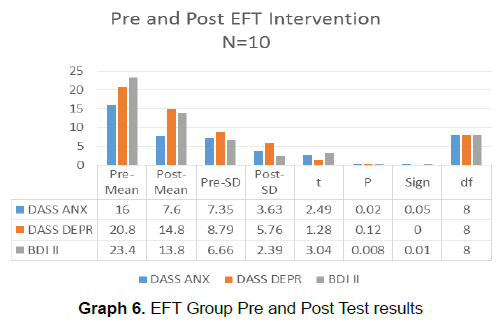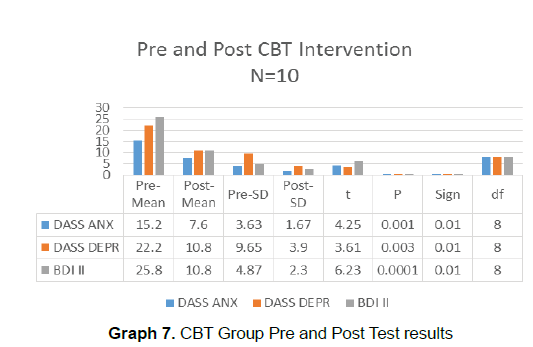Cognitive Behavioural Therapy and Emotional Freedom Technique in Reducing Anxiety and Depression in Indian Adults
Received: 01-Jan-1970 / Accepted Date: 01-Jan-1970 / Published Date: 30-Jun-2018 DOI: 10.4172/1522-4821.1000403
Abstract
WHO places Major Depressive Disorder (MDD), or depression, as the fourth leading cause of mental disability world-wide. According to a survey done by WHO in February 2017, found 7.5% of Indians suffer from major or minor mental disorders requiring expert intervention. National Mental Health Survey of India in 2015-2016 reports that one in 20 Indians suffer from Depression especially women in the age-group of 40-49 years suffers more. Earlier research indicated that Cognitive Behavioural Therapy (CBT) represents a superior approach in treating mild to severe depression symptoms. Whereas Emotional Freedom Technique (EFT) has received increased attention. The present study is in line with a study conducted in Australia in 2016 by Hannah Chatwin et al. The objective of the current study is to evaluate the comparative effectiveness of CBT and EFT in the treatment of anxiety and depression in Indian adults. Random subjects (n = 10) were selected from Ahmedabad (a metro city) in India who were screened positive for anxiety disorder and depression using Depression, Anxiety and Stress scale (DASS21) and Beck Depression Inventory (BDI2). These subjects were randomly assigned to an 8 week CBT or EFT treatment program with 1 session per week. All participants were screened after 3 sessions, 5 sessions, 8 sessions and after 1 month of follow up using DASS21 and BDI2. Findings of the study depict that both intervention approaches produce significant reductions in anxiety and depressive symptoms. The EFT treatment produced marked improvement in depression after 3 sessions. After 8 weeks of intervention, the CBT group reported significant improvement in depression while EFT intervention therapy showed significant results after 1 month of follow up. Examination of individual cases showed clinically significant improvement in anxiety and depression across both interventions. The results are consistent with the previous studies by Hannah Chatwin et al. (2016). Present findings suggest that EFT is of paramount importance as pivotal tool in managing anxiety and depression in Indian population.
Keywords: CBT, EFT, Anxiety, Depression
Introduction
Depression and anxiety causes significant impairment in daily life. A survey done in February 2017 by WHO reports that Depression is the fourth leading cause of mental disorder (Chatwin et al. 2016) and 7.5% Indians suffer from major to minor mental illness (Iyer, 2017). National Institute of Mental health and Neuroscience conducted a survey in October 2016 and reported that one in 20 Indians suffer from Depression and women in the age-group of 40-49 years suffers more (Times of India, 2016). In India there is still a stigma attached to seeking psychiatric help and women primarily are less likely to receive any help or are discouraged to seek help. Many Indians still don’t see depression as an ailment.
A pilot study “Effectiveness of Cognitive Behavioural Therapy and Emotional Freedom Techniques in Reducing Depression and Anxiety among Adults” was conducted by Hannah Chatwin et al. in 2016 in Australia. The results revealed clinically significant improvements in anxiety and depression with both interventions. CBT group reported a significant reduction in depression postintervention, which was not maintained with time. While EFT group reported a delayed effect with a significant reduction in symptoms after 3- and 6-months follow-ups. The individual cases revealed clinically significant improvements in anxiety across both interventions (Chatwin et al. 2016). After doing the literature review, no past studies in line with Hannah Chatwin et al. study comparing CBT and EFT in reducing anxiety and depression in Indian population was found. The author has been using the EFT therapy regularly to help clients with variety of problems like depression, anxiety, OCD, stress, etc. Thus the author chose to evaluate the effectiveness of CBT and EFT in reducing anxiety and depression in Indian adults as a pilot study.
In the present study the participant who were screened positive for anxiety and depression disorder were not treated clinically. They were either not aware of their depression and anxiety or were not ready to acknowledge it.
Literature Review
The literature search for this study was completed using Google Search and references from the papers that were retrieved.
Benor et al. (2009) conducted a study on effectiveness of WHEE (Wholistic Hybrid Derived From Eye Movement Desensitization and Reprocessing and Emotional Freedom Technique), CBT and EFT in the treatment of test anxiety among university students. WHEE and EFT showed significant effects in only 2 sessions as compared to 5 sessions for the CBT.
Church et al. (2010) in his study on “The treatment of combat trauma in veterans” using EFT confirmed the effectiveness of EFT in bringing significant reductions in the symptoms of depression and anxiety in 5 sessions that were maintained at the 3 and 6 month follow-up.
Church et al. (2012) conducted a controlled trial for depression in college students using EFT. The results indicated that four 90 minute group EFT sessions significantly decreased depressive symptoms at post-test and concluded that EFT is clinically useful and cost effective technique.
Church D. (2013) published a paper on Clinical EFT as an Evidence-Based Practice for the Treatment of Psychological and Physiological Conditions and concluded that Clinical EFT is an evidence based stable, safe and reliable treatment for psychological and medical diagnosis in primary care settings.
Clond M. (2016) in a study on “Emotional Freedom Techniques for Anxiety: A Systematic Review with Meta-analysis” EFT treatment showed a significant decrease in anxiety.
Conal Twomey, Gary O’Reilly & Michael Byrne. (2014) in their research on, “Effectiveness of cognitive behavioural therapy for anxiety and depression in primary care: a meta-analysis” concluded that multi-modal CBT is effective for anxiety and depression symptoms in primary care.
Feinstein, D. (2012) in paper on “Acupoint stimulation in treating psychological disorders: Evidence of efficacy” got positive result in few treatments of EFT.
Gaesser Amy H. & Karan Orv C. (2016) in a study on “Emotional Freedom Technique and Cognitive-Behavioural Therapy to Reduce Adolescent Anxiety: A Pilot Study” concluded that EFT is an effective intervention technique to significantly reduce anxiety for high-ability adolescents.
Hofmann S, Asnaani A, Vonk IJ., Sawyer A. & Fang A. (2012) in a study on “The efficacy of cognitive behavioural therapy: A review of meta-analyses” reported that the evidence base of CBT in general is very strong.
A study on “Efficacy of EFT in reducing public speaking anxiety: A randomized controlled trial” by Jones, S., Thornton, J., & Andrews, H. (2011) concluded that the EFT treatment group showed statistically significant decrease in public speaking anxiety.
Kalla Mahima et al. (2017) conducted a study to find out the experience of an EFT practitioner in using EFT technique to support patients with chronic disease. According to the findings, the EFT technique can give promising results to health care practitioners for the psychosocial aspect of chronic disease.
Karatzias et al. (2011) investigated the effect of EFT on PTSD. Subjects were given an eight week therapy treatment and the results showed a positive outcome and voluntary termination of treatment after an average of 3.8 sessions.
Patterson S.L. (2016) conducted a pilot study on “The effect of emotional freedom technique on stress and anxiety in nursing students” and concluded that EFT can be an effective tool in managing stress and reducing anxiety in nursing students.
Peta Stapleton et al. (2014) investigated the feasibility of using Clinical Emotional Freedom Techniques to treat Major Depressive Disorder in an Australian adult population by way of a therapeutic group setting for a period of eight weeks. The results indicated an improvement in each of the participants, with overall improvement for the treatment group for depressive symptoms.
Ragnhild S.H. et al. (2011) conducted a research on effectiveness of CBT on depression and anxiety in primary health care unit and concluded that CBT is potentially more effective for mild to moderate depression and anxiety than usual care. Conal T., Gary O. & Michael B. (2014) found similar result in a study, “Effectiveness of cognitive behavioural therapy for anxiety and depression in primary care: a meta-analysis”.
Rowe, J. (2005) in a study on ‘The effects of EFT on longterm psychological Symptoms’ using EFT and got promising results with significant decrease in psychological distress from pre workshop to post workshop and even after 1 month and 6 month follow up.
Sebastian, Brenda & Nelms, Jerrod (2016) in a study “The Effectiveness of Emotional Freedom Techniques in the Treatment of Posttraumatic Stress Disorder: A Meta-Analysis” concluded that a series of 4-10 EFT sessions is an effective treatment for PTSD with a diversity of populations.
Stapleton P, Bannatyne AJ, Urzi KC, Porter B, & Sheldon T (2016) assessed the effectiveness of CBT and EFT in the treatment of food cravings. Both the groups reported significant reductions in food cravings post-treatment and after 6 month follow-up.
Zhang Y, Feng B, Xie JP, Xu FZ, & Chen J. (2011) conducted a comparative study on “Clinical study on treatment of the earthquake-caused post-traumatic stress disorder by cognitivebehaviour therapy and acupoint stimulation”. Results showed improvement in both groups (CBT treatment alone and CBT with acupoint stimulation) but a significantly stronger improvement was seen in CBT with acupoint stimulation.
However, there was not enough data available to compare EFT to conventional treatment i.e. CBT for reducing depression and anxiety in the Indian population. Further research is needed to establish the relative effectiveness of EFT in the Indian context.
Anxiety
The dictionary meaning of anxiety is “a feeling of worry, nervousness, or unease about something with an uncertain outcome” (https://en.oxforddictionaries.com). According to the American Psychological Association (APA) “Anxiety is an emotion characterized by feelings of tension, worried thoughts and physical changes like increased blood pressure. People with anxiety disorders usually have recurring intrusive thoughts or concerns. They may avoid certain situations out of worry. They may also have physical symptoms such as sweating, trembling, dizziness or a rapid heartbeat” (American Psychological Association).
The essential features of generalized anxiety disorder according to DSM V are “excessive anxiety and worry about a variety of topics, events, or activities. Worry occurs more often than not for at least 6 months and is clearly excessive. Excessive worry means worrying even when there is nothing wrong or in a manner that is disproportionate to the actual risk”(American Psychiatric Association, 2013).
Depression
Dictionary meaning of depression is “feelings of severe despondency and dejection” (Oxford Dictionaries, 2018). According to APA “Depression is more than just sadness. People with depression may experience a lack of interest and pleasure in daily activities, significant weight loss or gain, insomnia or excessive sleeping, lack of energy, inability to concentrate, feelings of worthlessness or excessive guilt and recurrent thoughts of death or suicide” (http://www.apa.org).
According to DSM V Depression symptoms can vary from mild to severe and a person may experience feeling of sadness, loss of interest, changes in appetite, change in sleep, loss of energy, feeling of worthlessness, suicidal thoughts, difficulty concentrating and the symptoms should last at least for two weeks (American Psychiatric Association, 2013)
EFT
Dr. Roger Callahan found that tapping on certain meridian points reduces anxiety and fear and in 1980 he developed the Energy Psychology technique called Thought Field Therapy (TFT) (Lewis, 2013). According to him worries are the root cause of negative emotions and they are linked to a meridian point on the body. To eliminate the negative emotions a precise sequence of meridian points must be tapped (Trubo & Callahan, 2001). Later Gary Craig simplified TFT and named it Emotional Freedom Technique (EFT). He described the unique feature of EFT in one statement, “The cause of all negative emotions is a disruption in body’s energy system” (Craig, 1980).
EFT is a blend of Acupuncture and Mind-Body Medicine, both of which have been supported by scientific studies for decades (Craig, 1980). Past reports suggest that energy psychology is an effective psychotherapy treatment in improving psychological functioning (Rowe, 2005).
EFT combines the exposure to emotional trigger, Chinese principles of acupuncture and the conventional cognitive behavioural therapy. It works by gently tapping on the meridian points (Lewis, 2013; Kalla & Khalil, 2014) and contributes immensely in releasing blockages within the energy system which causes emotional discomfort. These blockages in our energy system lead to not only a stressful life but manifests to various physical, emotional and psychological syndromes, such as lack of confidence and self-esteem, feeling stuck, anxious or depressed, etc. These congestions hinders smooth and harmonious flow and lead to limiting beliefs and behaviours (The Energy Tgerapy Center).
A cognitive approach with acupuncture leads to a change in the behaviour, subconscious thought process and neurochemical bases of the psychological problem. Similar to CBT, EFT compiles on the fact that rather than resistance of a particular condition, selfacceptance will reduce the suffering (Kalla & Khalil, 2014).
A person mentally focuses on an emotional trigger while tapping on certain meridian points on their face and upper body with their fingertips while saying a statement of self-acceptance. EFT seems to balance disturbances in the meridian system which in turn balances the negative emotions and the physical discomfort attached to it at conscious and sub-conscious level. Thus, EFT reduces the time spent by conventional therapy procedures (Craig, 1980).
CBT
Aaron Beck (1960) is considered the father of CBT and his theories are widely used in treating depression and anxiety (Beck, 2004). According to the Beck Institute, CBT is “a time-sensitive, structured, present-oriented psychotherapy directed toward solving current problems and teaching clients skills to modify dysfunctional thinking and behaviour” (Positive Psychology Program, April, 2017). According to the concept of CBT our thoughts and feelings play a fundamental role in our behaviour. CBT focuses on changing thoughts and behaviours that cause disturbing emotions. CBT combines cognitive and behavioural therapies to help clients understand the connection between thoughts, feelings and behaviour, and teaches them effective coping strategies for dealing with different problems throughout life (Cherry, 2017).
According to the National Health Service (NHS) of England, “CBT is based on the concept that your thoughts, feelings and behaviour are interconnected, and constantly influence one another.” How we think about a situation determines how we feel and react to a particular situation. CBT deals with current problems, rather than focusing on past issues (Positive Psychology Program, April, 2017). This is another common factor between EFT and CBT.
As shown in Figure 1 Our pattern of thinking makes us perceive the world in a specific way. According to Aaron Beck the perceptions and interpretations of depressed persons are distorted. Depressed individuals are occupied in “cognitive errors” (Davis, 2016), such as negative and fearful thoughts and biased information processing (Ragnhild et al. 2011). These errors in thoughts are automatic and the individual believes them to be true. CBT focuses on altering these automatic thoughts. In simple words CBT is a focused, short term and structured method to treat a variety of mental health disorders (Kristina & Byrne, 2013).
Hypothesis
Ho 1-There is no difference in the effect of CBT and EFT intervention therapy in reducing anxiety in Indian adults.
Ho 2-There is no difference in the effect of CBT and EFT intervention therapy in reducing depression in Indian adults.
H1 1-There is a significant reduction in anxiety and depression post EFT intervention in Indian adults.
H1 2-There is a significant reduction in anxiety and depression post CBT intervention in Indian adults.
Materials and Methods
Material
• Depression, Anxiety and Stress Scale 21 (DASS 21)
• Beck Depression Inventory II (BDI II)
• Consent Form
• Demographic Information Form
Method
Participants
A survey done by NIMHANS in 2016 reported that one in 20 Indians suffer from Depression and women in the age-group of 40-49 years suffer more. Based on this data, 15 participants in the age group of 35 to 55 years were randomly selected from general population, Ahmedabad, India and were screened for anxiety and depression using Beck Depression Inventory-second edition (BDIII) (Beck et al. 1996) and Depression, Anxiety, and Stress Scales 21 (DASS-21) (Lovibond & Lovibond, 1995). Due to personal reasons some of the participants dropped out. Ahmedabad being a conservative city there is a stigma attached to seeing a psychologist. Male don’t volunteer for research work so easily, especially when a researcher is a female. Thus there was a difference in the gender equality.
BDI II (Aaron Beck, 1996) is a revised version of BDI and measures the severity of depressive symptoms based on DSM 5. BDI II contains 21 questions. Participants were asked to specify on a 4-point Likert scale the extent to which they had experienced negative emotional states of depression during the past two weeks (Beck et al. 1996).
The DASS 21 scale (Lovibond, S.H. & Lovibond, P.F., 1995) is a set of three self-report scales designed to measure the negative emotional states of depression, anxiety and stress. Participants were asked to specify on a 4-point scale the extent to which they had experienced negative emotional states of depression, anxiety, and stress during the past week. In the current study, anxiety and depression subscale scores were used for data analysis. Each of the three DASS-21 scales contains 7 items, divided into subscales with similar content. The DASS-21 development was based on the assumption that difference between the stress, anxiety and depression experienced by normal subjects and clinical patients is mainly of degree (Lovibond & Lovibond, 1995).
10 participants who were screened positive for anxiety and depression were included for the study. They were asked to sign the consent form and provide demographic information. The participants were then randomly assigned to 8 weeks of EFT (N = 5) or CBT (N = 5) therapy program. They were screened for anxiety and depression after 3 sessions, 5 sessions, 8 sessions and after 1 month using DASS 21 and BDI II. The statistical analysis was done using Small Sample t Test.
Procedure
8 once a week individual therapy sessions were conducted for both EFT and CBT programs by the researcher. A similar structure was used for both the interventions. Participants were contacted after 1 month post intervention to complete the same questionnaires.
EFT Intervention
The procedure involved participants to focus on a distressing thought, create an intensity rating, initiate a setup phrase, and then completing the tapping sequence using acupressure points. Psychological Reversal means energy in the body is disturbed. It is self-defeating, negative thinking which often occurs subconsciously and may be outside one’s awareness. It should be neutralized with affirmative statement for cognitive shift.
At the beginning of each session participants were asked to rate their subjective level of discomfort on the scale of 1 to 10. Then based on emotional difficulty being experienced a setup phrase was initiated. The affirmative statement of acceptance of the difficulty was repeated 3 times while tapping on “Karate Chop” point, as per Craig’s EFT manual. e.g. “Even though I have this Problem, I deeply and completely accept myself”. The sequence of tapping points- TH, EB, SE, UE UN, UL, CB, UA and WR was taught and the participants were asked to get tuned into emotional discomfort while tapping on the meridian point and repeating the affirmative statement. The whole cycle was repeated till the subjective level of discomfort reduced to zero level. After the 1st round the set up phrase was rephrased as, “Even though I still have some of this remaining Problem. I deeply and completely accept myself” (Craig, 2010).
At end of each session they were given home plan and asked to give feedback for the session. Home plan included tapping sequence, thought journal and breathing exercise.
CBT Intervention
The CBT session was conducted using conventional CBT program. The aim of the intervention was to modify distorted thinking, dysfunctional behaviour, and distressing feeling by teaching coping strategies. In simple words the goal was to replace negative thoughts with productive behaviour.
The CBT program involved identifying and challenging the harmful automatic thoughts, restructuring negative automatic thoughts and core beliefs and scheduling and monitoring activities. Participants were given different worksheets like Alternative Action Formulation, Functional Analysis and Longitudinal Formulation and were asked to maintain a thought journal as home plan (Positive Psychology Program, March, 2017).
At the beginning of each session participants were asked to rate their subjective level of discomfort and describe their feelings of this week, compared to earlier weeks. Then they were asked to name the main problems they faced during the week and the plan for the session was discussed. To create a bridge between the last and present session they were asked whether anything unusual happened during the week which they would like to share. This was followed by discussing self-help assignments. After prioritizing the issues the problems were discussed one by one. The truthfulness of their thoughts and beliefs in the difficult situation were assessed. New skills to modify their negative thinking and behaviour and solving problems on their own were taught. They were asked to summarize and write down important points in their own words and home plan activities were scheduled until the next session. At the end of the session they were asked to give a feedback for the session and were asked to rate their subjective level of discomfort.
In each consecutive session at the beginning the home plan was reviewed.
Statistical Methods
The statistical analysis was done using small samples t test and within subject t test. A statistical significance in t test indicates whether or not the difference between the averages of two groups most likely reflects a “real” difference in the population from which the groups were sampled. We are interested in finding out how much difference exists between subjects’ scores before the treatment and after the treatment and is there any significant difference found between the two intervention therapy or not (Garrett, 1966).
Results
Graph 1
As shown in Graph 1 the total sample size was 10, consisting of 9 women and 1 man between the age group of 35-55 years. Pre-test results show no statistically significant difference in both intervention groups. Average depression in both the groups on BDI II scale was 23.4 (EFT) and 25.8 (CBT) respectively, which is in moderate range and on DASS 21 scale it was 20.8 (EFT) and 25.8 (CBT) respectively, which is in the severe range. Average anxiety in both the groups was 16 (EFT) and 15.2 (CBT), which is in severe range.
Graph 2
As shown in Graph 2, after 3 sessions, average depression in both the groups on BDI II scale was 18.8 (EFT) which is in the range of border line clinical depression and 22.6 (CBT) which is in moderate range. Average depression on DASS 21 scale was 17.2 (EFT) and 20 (CBT) respectively, which is in the moderate range. Average anxiety in both the groups was 14 (EFT) and 13.2 (CBT), which is in the moderate range. There was no significant difference found in reduction of anxiety and depression between both intervention therapies after 3 weeks.
Graph 3
As shown in Graph 3, average depression after 5 sessions in both the groups on BDI II scale was 17.2 (EFT) and 18.6 (CBT) respectively, which is in the range of borderline clinical depression and on DASS 21 scale, it was 15.6 (EFT) and 17.2 (CBT) respectively, which are in the moderate range. Average anxiety in both the groups are 11.6 (EFT) and 11.2 (CBT), which are in the moderate range. There was no significant difference found in reduction of anxiety and depression between both intervention therapies after 5 weeks.
Graph 4
As shown in Graph 4, average depression after 8 sessions in both the groups on BDI II scale was 13.8 (EFT) which is in the range of mild mood disturbance and 10.6 (CBT) which is in the normal range. The result is statistically significant at 0.05 level. Participants who received CBT therapy showed better results than participants who received EFT therapy. On DASS 21 scale it was 14.8 (EFT) which is in the moderate range and 10.8 (CBT) which is in the mild range. Average anxiety in both the groups was 8.0 (EFT) and 8.4 (CBT), which is in the mild range. There was a significant reduction in depression in CBT group post intervention than EFT group. There was no significant difference found between two therapies in reduction of anxiety.
Graph 5
As shown in Graph 5, average depression after 1 month of follow up in both the groups on BDI II scale was 8 (EFT) which is in the normal range and 11 (CBT) which in the range of mild mood disturbance. On DASS 21 scale it was 9.6 (EFT) which is in the normal range and 10.4 (CBT) which is in the mild depression range. Average anxiety in both the groups was 5.6 (EFT) and 6.4 (CBT), which is in the normal range. A significant difference at 0.05 level was found in reduction of depression on BDI II scale. Participant who received EFT therapy showed significantly better result in reduction of depression post therapy.
Graph 6
The above results show that (Graph 6) there were statistically significant improvements found in anxiety and depression pre and post intervention in participants who received EFT therapy. There was a statistically significant difference at 0.05 level in anxiety on DASS 21 scale and at 0.01 level in depression on BDI II scale.
Graph 7
The above results show that (Graph 7) there was a statistically significant improvement found in anxiety and depression pre and post intervention in the CBT group. There was a statistically significant difference at 0.01 levels in anxiety and depression on DASS 21 and BDI II scales.
Discussion
Observationally, after 3 weeks of intervention, there was a reduction in depression on BDI II scale in EFT group from moderate to borderline clinical depression. The results support the past study by Benor et al. 2009, where EFT showed significant effects in only 2 sessions as compared to 5 sessions for the CBT.
One of the subjects who had severe anxiety and moderate depression pre intervention, showed noticeable improvement with EFT intervention therapy. Her anxiety score came down in the range of moderate and depression came down in the range of mild depression. The subject did not show much improvement after 8 sessions of EFT but after one month of follow up the subject became normal and the score across all the tests were in normal range i.e. > 10.
Observationally, after 5 sessions there was a reduction in anxiety and depression in both the intervention therapies. The Results support the findings of Zhang Y et.al. 2011, where CBT with acupoint stimulation showed significantly stronger improvement.
At 8 weeks, the CBT intervention group reported significant improvement in depression from borderline clinical depression to mild mood disturbance on BDI II scale and from moderate to mild on DASS 21 scale. The scores came down from 18.6 to 10.6 on BDI II scale and from 17.2 to 10.8 on DASS 21 scale. Results support the findings of Hannah Chatwin et al. Ragnhild et al. Conal et al. where they concluded that CBT is potentially more effective for mild to moderate depression and anxiety than usual primary care treatment. After 8 weeks of therapy the range of depression in EFT group came down from borderline clinical depression to mild mood disturbance. The results support the findings of Peta Stapleton et al. where they reported improvement in the participants having major depression with 8 sessions of EFT.
Another subject who had moderate anxiety and severe depression pre-intervention, showed noticeable improvement in anxiety and depression with CBT intervention therapy. The anxiety score came down in the range of mild anxiety and depression on BDI II came down in the range of mild mood disturbance. Even after continuing the home plan there was no further improvement seen in the subject after 1 month of follow up.
After 1 month of follow up, the EFT group significantly showed further improvement in depression and scores across all the tests were with in normal range. The CBT group reported a significant reduction in depression after 8 sessions, while EFT group reported a delayed effect. Results support the study conducted by Hannah Chatwin et al.
The individual cases revealed clinically significant improvements in anxiety and depression across both the interventions. Results support the study conducted by Hannah Chatwin et al.
The overall results indicated that a slightly greater effect was achieved by the CBT group in terms of depression scores postintervention. Findings are highly consistent with prior studies that confirmed efficacy of CBT, such as Hannah Chatwin et al. & Hofmann et al. The results are also consistent with past studies that confirmed the efficacy of EFT, such as Church D., Jones, S. et al. Kalla Mahima et al. Patterson S.L. & Rowe J.
The present study supports the past studies in concluding that EFT can be an effective therapy for treating anxiety and depression in the Indian population. The present study was a comparative study to investigate the efficacy of EFT and CBT in reducing anxiety and depression in the Indian population. In the present study the effectiveness of EFT in treating depression and anxiety is promising, but direct management of emotional stage is not well understood. Scientifically established comparative studies between EFT and CBT in Indian population for treating depression and anxiety are yet to be conducted.
Conclusion
The current study is in line with the pilot study by Hannah Chatwin to examine and compare the effectiveness of CBT and EFT in reducing depression and anxiety among adults. The results indicated that a significant (p<0.05) effect was achieved by the CBT group in terms of depression scores post-intervention, while EFT group reported a delayed effect with a significant (p<0.05) reduction in symptoms after 1 month’s follow-up. The results are consistent with the previous study by Hannah Chatwin et al. The analysis of individual cases in both intervention groups revealed clinically valid improvements in depression and anxiety scores from pre-treatment to post-treatment.
The findings of the present study indicate that EFT may be an effective treatment approach for anxiety and depression and supports the finding of Patterson S.L. After the above study the researchers strongly recommend that EFT is of paramount importance as a pivotal tool in managing anxiety and depression in the Indian population. A direct control of emotional state or its control through cognitive processing are both indeed useful and have equally strong effect in correcting behaviour.
Limitation and Recommendation
Had the sample size been large enough, the effectiveness and variability of EFT and CBT interventions would have been more apparent. Further research on efficacy of CBT and EFT in reducing depression and anxiety symptoms in a larger sample from varied cultures would provide more valuable inputs.
References
American Psychological Association. Encyclopaedia of Psychology: 8 Volume Set.
American Psychiatric Association. (2013). Diagnostic and statistical manual of mental Disorders (Fifth Edition). Washington, D.C.
Beck, A.T., Steer, R.A. & Brown, G. (1996). Beck Depression Inventory. Psychological Corpo. Harcourt Brace & Co. NY, USA.
Beck, A.T., Steer, R.A. & Brown, G. (1996). BDI-II, Beck depression invent.
Beck, A.T., Steer, R.A., Ball, R. & Ranieri, W. (1996). Comparison of beck depression inventories -IA and -II in psychiatric outpatients. J Personal Assess. 67(3): 588-597.
Beck, A. (2004). The Grawemeyer Awards, Louisville, KY: University of Louisville/Louisville Presbyterian Theological Seminary, 2009.
Benor, D.J., Ledger. K., Toussaint, L., Hett, G., & Zaccaro, D. (2009). Pilot study of emotional freedom techniques, wholistic hybrid derived from eye movement desensitization and reprocessing and emotional freedom technique, and cognitive behavioural therapy for treatment of test anxiety in university students. Explore, 5(6), 338-340.
Butler, A.C., Chapman, J.E., Forman, E.M., & Beck, A.T. (2005). The empirical status of cognitive behavioural therapy: A review of meta-analyses. Clin Psych Rev, 26(1), 17-31.
Chatwin, H., Stapleton , P., Porter , B., Devine, S. & Sheldon , T. (2016). The effectiveness of cognitive behavioral therapy and emotional freedom techniques in reducing depression and anxiety among adults: A pilot study. Integr Med (Encinitas) , 15 (2), 27-34.
Cherry, K. (2017). What is cognitive behavioral therapy? Process, types, components, uses, and effectiveness. Verywellmind.
Church, D. (2010). The treatment of combat trauma in veterans using EFT (Emotional Freedom Techniques): A pilot protocol. Traumatol, 16, 55-65.
Church, D., De Asis, M.A. & Brooks, A.J. (2012). Brief group intervention using emotional freedom techniques for depression in college students: A randomized controlled trial. Depress Res Treat, 2012, 257172.
Church, D. (2013). Clinical EFT as an Evidence-Based Practice for the Treatment of Psychological and Physiological Conditions. Sci Res Psychol, 4(8), 645-654.
Clond, M. (2016). Emotional freedom techniques for anxiety: A systematic review with meta-analysis. J Nerv Ment Dis, 204(5), 388-395.
Craig, G. (1980). What is EFT? - Theory, science and uses. The Gary Craig Official EFT™ Training Centers.
Craig, G. (2010). The EFT Manual sixth edition. Santa Rosa, CA: Energy Psychology Press.
Davis, K. (2016). Cognitive behavioral therapy: How does CBT work? Medical News Today.
Feinstein, D. (2012). Acupoint stimulation in treating psychological disorders: Evidence of efficacy. Rev Gen Psychol, 16, 364-380.
Gaesser Amy, H. & Karan Orv, C. (2016). Emotional freedom technique and cognitive-behavioral therapy to reduce adolescent anxiety: A pilot study. J Altern Complement Med, 23(2), 102-108.
Garrett, H.E. (1966). Statistics in psychology and education. International Book Bureau, Hyderabad, India.
Hofmann, S., Asnaani, A., Vonk, I.J., Sawyer, A. & Fang, A. (2012). The efficacy of cognitive behavioural therapy: A review of meta-analyses. Cognit Ther Res, 36(5), 427-440.
http://www.apa.org/topics/depression/index.aspx
https://en.oxforddictionaries.com/definition/anxiety.
Iyer, M. (2017). 7.5% Indians suffer from mental disorders: WHO report. The times of India.
Jones, S., Thornton, J., & Andrews, H. (2011). Efficacy of EFT in reducing public speaking anxiety: A randomized controlled trial. Rev Gen Psychol, 3(1), 19-32.
Kalla, M. & Khalil, H. (2014). The effectiveness of Emotional Freedom Techniques (EFT) for improving the physical, mental and emotional health of people with chronic diseases and/or mental health conditions: A systematic review protocol. JBI Database of System Rev Implement Rep, 12(2), 114-124.
Kalla, M., Simmons, M., Robinson, A. & Stapleton, P. (2017). Emotional freedom techniques (EFT) as a practice for supporting chronic disease healthcare: A practitioners’ perspective, Disabil Rehabil, 40(14), 1654-1662.
Karatzias, T., Power, K., Brown, K., McGoldrick, T., Begum, M., Young, J., et al. (2011). A controlled comparison of the effectiveness and efficiency of two psychological therapies for posttraumatic stress disorder: Eye movement desensitization and reprocessing vs. Emotional freedom techniques. J Nerv Ment Dis, 199(6), 372-378.
Kristina, F. & Byrne, M. (2013). The key principles of cognitive behavioural therapy. InnovAiT, 6(9), 579-585.
Lewis, A. (2013). What is EFT. EFT - Emotional Freedom Techniques – Australia, Nov.
Lovibond, S.H. & Lovibond, P.F. (1995). Manual for the depression anxiety & stress scales. (2 Ed.) Sydney: Psychology Foundation.
Oxford Dictionaries. (2018). Oxford University Press.
Paradigm Malibu Adolescent Treatment Center. Teen Cognitive Behavioral Therapy (CBT).
Patterson, S.L. (2016). The effect of emotional freedom technique on stress and anxiety in nursing students: A pilot study. Nurse Educ Today, 40, 104-10.
Positive Psychology Program. March, 2017.
Positive Psychology Program. April, 2017.
Ragnhild, S.H., Christine, S., Nils, K., Martin, E. & Knut, W. (2011). Effectiveness of cognitive behavioural therapy in primary health care: A review. Fam Practice, 28(5), 489-504.
Rowe, J. (2005). The effects of EFT on long-term psychological symptoms. Counsel Clin Psychol J, 2(3), 104.
Sebastian, B. & Nelms, J. (2016). The effectiveness of emotional freedom techniques in the treatment of posttraumatic stress disorder: A meta-analysis. Explore, 13(1), 16-25.
Stapleton, P., Bannatyne, A.J., Urzi, K.C., Porter, B. & Sheldon, T. (2016). Food for thought: A randomised controlled trial of emotional freedom techniques and cognitive behavioural therapy in the treatment of food cravings. Appl Psychol Health Well Being, 8(2), 232-257.
Stapleton, P., Devine, S., Chatwin, H., Porter, B. & Sheldon, T. (2014). A feasibility study: Emotional freedom techniques for depression in australian adults. Curr Res Psychol, 5(1), 19-33.
Times of India. (2016). 13.7% Indians are mentally ill. Bangalore Mirror Bureau.
The Energy Tgerapy Center. London.
Trubo, R. & Callahan, R. (2001). Tapping the healer within: using thought field therapy to instantly conquer your fears, anxieties, and emotional distress. Chicago, Ill: Contemporary Books. ISBN 0-8092-9880-5.
Twomey, C., O’Reilly, G. & Byrne, M. (2014). Effectiveness of cognitive behavioural therapy for anxiety and depression in primary care: A meta-analysis. Family Practice, 32(1), 3-15.
Zhang, Y., Feng, B., Xie, J.P., Xu, F.Z. & Chen, J. (2011). Clinical study on treatment of the earthquake-caused post-traumatic stress disorder by cognitive-behaviour therapy and acupoint stimulation. J Tradit Chin Med, 31(1), 60-63.
Select your language of interest to view the total content in your interested language
Share This Article
Open Access Journals
Article Tools
Article Usage
- Total views: 12797
- [From(publication date): 0-2018 - Nov 10, 2025]
- Breakdown by view type
- HTML page views: 12110
- PDF downloads: 687


